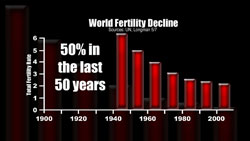Learn More
Questions & Answers About: “The New Economic Reality: Demographic Winter:” Parts 1 and 2
 Question: What does the expression “Demographic Winter” mean?
Question: What does the expression “Demographic Winter” mean?
Answer: The phrase demographic winter refers to what happens when human populations are unbalanced - with too few children being born, and the elderly living longer. The effect goes well beyond mere numbers.
Demographer Philip Longman (author of “The Empty Cradle: How Falling Birthrates Threaten World Prosperity”) observes: “The ongoing global decline in human birthrates is the single most powerful force affecting the fate of nations and the future of society in the 21st. century.”
Worldwide, birthrates have declined by more than 50% in the past 30 years (since 1979). There are now 59 nations, with 44% of the world’s population, with below-replacement fertility
Sometime in this century, the world’s population will begin to decline. (The United Nations Population Division says that, worldwide, we could achieve below-replacement fertility by 2030.) At a certain point, the decline will become rapid. We may even reach what demographers call population free-fall in our lifetimes.
Russia is losing three-quarters-of-a-million people a year. Its population (currently 145 million) is expected to fall by one-third by 2050.
 The term “nuclear winter,” popularized in the 1980s, alluded to the catastrophic environmental impact of a nuclear war. The long-term consequences of Demographic Winter could be equally devastating.
The term “nuclear winter,” popularized in the 1980s, alluded to the catastrophic environmental impact of a nuclear war. The long-term consequences of Demographic Winter could be equally devastating.
Question: What is replacement fertility, and why is the number 2.13 so important?
Answer: Replacement fertility is the point of equilibrium at which a country’s population is neither growing nor declining. In order to maintain current population, the average woman must have 2.13 children during her lifetime. She needs to replace herself and a man. Because some children will die before reaching maturity and having children of their own, slightly more than two children are needed – hence 2.13.
A birthrate of more than 2.13 equals population growth. A birthrate of less than 2.13 means long-term population decline.
Question: If birthrates are declining, why does the world’s populationcontinue to grow?
Answer: If it’s already in motion, car in neutral will continue moving forward for a while, especially if it’s going downhill, even if gas isn’t being injected into the engine.
Today’s population growth is due to two factors: 1) higher fertility rates in the 1950s and 60s, and 2) people living longer than ever before.
Declining birthrates will equal a declining population worldwide at some point beginning around mid-century. In the West (especially in Europe) population decline will become a reality much sooner.
In some countries, such as Russia and some other Eastern European countries, it’s already happening.
A nation’s demographic future can be seen in its current birthrate. In Europe, the number of children under 5 has declined by 36% since 1960. Worldwide, there are 6 million fewer children under 6 years of age today than there were in 1990. If present trends continue, the United Nations estimates that by 2050 there will be 248 million fewer children in the world then there are now.
Question: Where are birthrates lowest?
Answer: Of the 10 countries with the lowest birthrates, 9 are in Europe. Overall, the European fertility rate is 1.3, well below replacement level (2.1). No European nation has a replacement-level birthrate.
Italy’s fertility rate is 1.2. Spain’s is 1.1. That means in the not-too-distant future, absent massive immigration, these countries will lose half of their people in every generation.
Russia’s birthrate fell from 2.4 in 1990 to 1.17 today – a decline of more than 50% in less than 20 years. Each year, there are more abortions than live births in the Russian Federation.
While birthrates are also plummeting in developing nations, most still have above-replacement fertility – for the time being.
The U.S. fertility rate is just at the replacement level, due in part to higher immigrant birthrates. How long this will continue is anyone’s guess. It’s also important to note that all of the factors driving down birth rates elsewhere in the world are present here as well.
Question:What are the consequences of demographic decline?
Answer: Economist Robert J. Samuelson wrote in a June 15, 2005 column in The Washington Post: “It’s hard to be a great power if your population is shriveling.” Samuelson warned: “Europe as we know it is going out of business…. Western Europe’s population grows dramatically grayer, projects the U.S. Census Bureau. Now about one-sixth of the population is 65 and older. By 2030, that could be one-fourth and by 2050, almost one-third.”
By the mid-point of this century, 16% of the world’s population will be over 65. In developed nations, today, 20% of the population is over 60. By 2050, the proportion of elderly will rise to 36%.By then, these societies will have two elderly for every child.
If present low birthrates persist, the European Union estimates there will be a continent-wide shortfall of 20 million workers by 2030. This leads Europeans to many questions: Who will operate the factories and farms in the Europe of the future? Who will develop the natural resources? Where will Russia find the soldiers to guard the frontiers of the nation with the largest land mass? Who will support and care for a graying population? How will health and pension systems be sustained?
This only skims the surface of the way demographic decline will change the face of civilization. Even the environment will be adversely impacted. With severely strained public budgets, developed nations will no longer be willing to shoulder the costs of industrial clean-up or a reduction of CO2 emissions.
Question: What factors contribute to demographic decline?
Answer: A number of social trends of the post-war era have converged to create a perfect demographic storm.
Men and women are delaying marriage, making it less likely they’ll have more than one or two children. Today in the West, almost one in two marriages ends in divorce. The children of divorce are less likely to marry and form families themselves.
More married women are putting off having children for careers. After 35, it becomes progressively harder for women to conceive.
The growth of cohabitation also has an impact. (In Scandinavia, almost as many couples are living together as married.)
Cohabitation is not conducive to childbearing or childrearing.
Over-arching all of these reasons is a culture of individualism that tells young adults that satisfaction comes from careers, romance, travel and “personal growth” – not from having children.
In addition, for the past 20 to 30 years, we have assumed that population growth was all bad, bad for the environment and economic development.
Thus, almost every aspect of modernity works against family life and in favor of singleness and small families or voluntary childlessness.
Question: Can’t the problem be fixed by increased immigration?
Answer: In a demographic sense, this is robbing Peter to pay Paul.
The host country gains people, but the home country loses. The developing world, which has seen its own birthrate cut in half since 1970 (from almost 6 to 2.9) can ill afford to lose large numbers through emigration.
Mass immigration changes the national character of the host country. Immigrants tend to have a lower education level than natives. Manynever learn the language of their new home or identify with its history and heritage. (Instead of being French-Algerian, they remain an Algerian who happens to be living in France.)
Citizens of developed countries often worry about the loss of national identity, and cultural changes on such a large scale are causing considerable social and political strife.
Question: Can’t demographic winter be countered by governments encouraging people to have more children?
Answer: This is being tried in Western Europe and Russia. The Russian Federation pays families a bonus of 250,000 rubles (the equivalent of $9,200) for every child after the first – in a nation where the average monthly wage is only $330. It’s not working.
Couples decide to have children for all kinds of reasons – religious, emotional, cultural, etc. Research has shown that prosperity seems to have an inverse effect on fertility. So while not having enough money may be a factor in a couple’s decision whether or not to have a child, already having money seems to increase a couple’s tendancy to have fewer children.
In addition to economic incentives, governments who see their country in jeopardy have also been instituting policies and programs to encourage and strengthen families.
Question: Doesn’t the United States have near-replacement fertility?
Answer: All of the factors that are leading Europe into the depths of Demographic Winter are present in the United States as well, including high divorce rates, the rise of cohabitation, families putting off child bearing to pursue careers, and voluntary childlessness.
The immigrant population and fundamentalist religious communities in the United States tend to have higher fertility, but even their fertility rates are falling, so that it is projected that the U.S. fertility rate will be about 1.95 by 2015 and 1.85 by 2020.
In addition, national economies are interconnected to such an extent that the impact of economic collapse in one country or region can be felt around the world.
The social, political and economic decline of previously stable nations can destabilize entire regions and create perils for neighbors and far-ways allies. The United States is connected to Europe economically and through multiple security treaties.
Question: What role did declining birth rates play in the current economic crisis?
Answer: Economist Harry S. Dent notes that 70% of GNP in the U.S. is consumer-driven. As the Baby Boomers aged, they began spending less, moving to smaller homes and planning for their retirement. Gen-X can’t fill the gap of the decline of spending by 81 million baby-boomers. This contributed to the slump in the housing market – when Boomers began selling rather than buying, there was a glut on the market and home sales began to decline. “Demographic Winter” predicted the financial crash of 2008 to within 18 months. The “Demographic Bomb” forecasts worse in store for our economy. At any given time only 15% of homes on the market are new construction, while 85% are used homes. As the baby-boom generation ages, the coming decades will see 60% too many homes on the market.
Question: Can the economic impact of declining birth rates be seen outside the United States?
Answer: Yes, in Japan, which has a birth rate of 1.25. Of the 10 nations with the lowest birth rates today, Japan is the only one outside of Europe. It also has the highest ratio elderly to children in the world. As the rising sun sets, where will the next generation of consumers and producers come from? While much of the industrialized world saw their economies grow in the 1990s, from 1990 to 2005, Japan’s stock market fell 80%.
Between 1990 and 2005. Its real estate market lost 60% of its value.
To order a copy of “The New Economic Reality: Demographic Winter” or view a trailer for the film, go to
www.theneweconomicreality.com.



